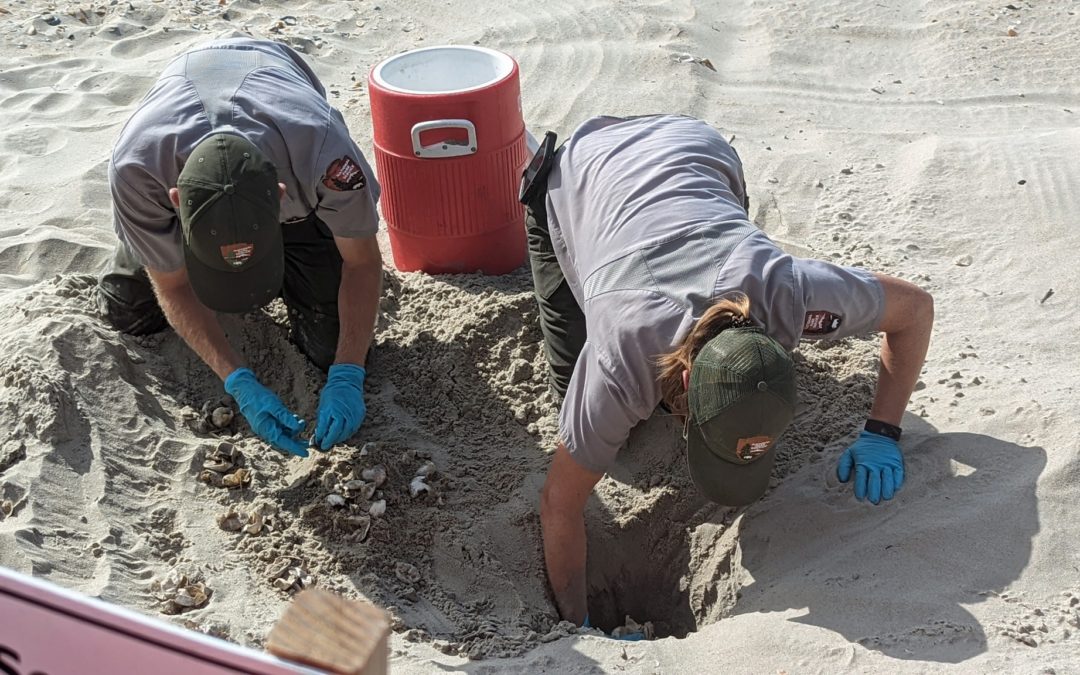Humans aren’t the only creatures that flock to the beaches of the Outer Banks. The sandy dunes and ever-changing shorelines play host to more than 300 bird species and dozens of reptiles. In the spring and summer, seven species of shorebirds make their nests in Cape Hatteras National Seashore. Some like the piping plover and American oystercatcher are solitary nesters, while others like the black skimmer, gull-billed tern, and least tern nest in large colonies on the open beach. All require large sections of undisturbed beach above the high tide line and below the dunes to safely hatch and fledge their chicks.
In addition to the shorebirds, five species of sea turtle have been confirmed nesting on the beaches of Cape Hatteras National Seashore: loggerhead, green, Kemp’s ridley, hawksbill, and leatherback. Loggerhead turtles make up roughly 95% of the sea turtle nests each year, with green turtles being the next most common at 3-5%. All five species are federally protected and face numerous threats from human disturbance to light pollution to depredation by coyotes, ghost crabs, and others.
For shorebirds and sea turtles alike, one of the biggest threats comes from loss of nesting habitat. “For sea turtles in particular, with potential sea level rise, you [are likely to] see higher erosion rates, which in a lot of cases is that sea turtles’ direct nesting habitat being lost,” says Supervisory Biological Science Technician William Thompson. Sea level rise coupled with urbanization, storm damage, and human disturbance reduce the amount of suitable habitat available for nesting.
Every year, the National Park Service works to protect crucial habitats for all the species that nest in Cape Hatteras National Seashore. Pre-nesting closures are put in place by March 15 for the solitary nesting shorebirds, followed by the colonial nesting species. Shorebirds will begin nest-building at the end of March, though nesting can continue into July if earlier nests fail. Biological Science Technicians, or “Bio Techs” for short, will closely monitor the nesting areas daily, adjusting the boundaries as needed and gathering data on the success of the nests. Many birds will also be banded, which allows scientists to track them over time.
Sea turtle patrols also begin in the spring, with Bio Techs rising before dawn to check for the telltale tracks that indicate a female sea turtle has laid her eggs in the sand. A small closure area is posted around each nest, which, like the shorebird nesting areas, is closely monitored. Sea turtle eggs will incubate for 50-65 days depending on the average sand temperature and will hatch anywhere from mid-July to early October, at which point park staff will excavate and inventory the nests.
Visitors to Cape Hatteras National Seashore can help protect all nesting species by respecting closure areas and keeping the beach clean from trash and debris. Don’t release balloons and try to limit the use of disposable plastics to keep those materials from ending up in the ocean. Help cut back on light pollution, which keeps the female turtles away from the beach in nesting season and disorients newly hatched turtles in hatching season. “It all starts with being responsible while utilizing our public lands,” says Thompson. “Pack it in, pack it out. Go in with the mentality of being conscious that there’s more than just humans around you.”
Adapted from the National Park Service. Originally published in the 2022 edition of the Outer Banks Group’s “In the Parks” newspaper.

